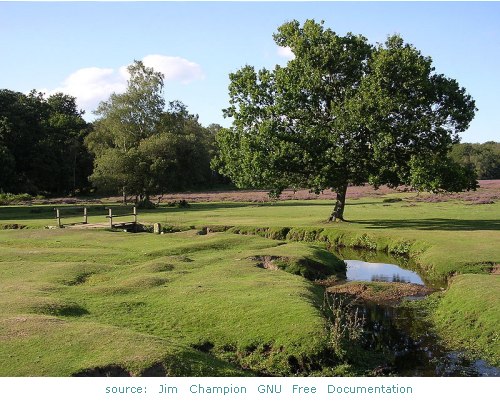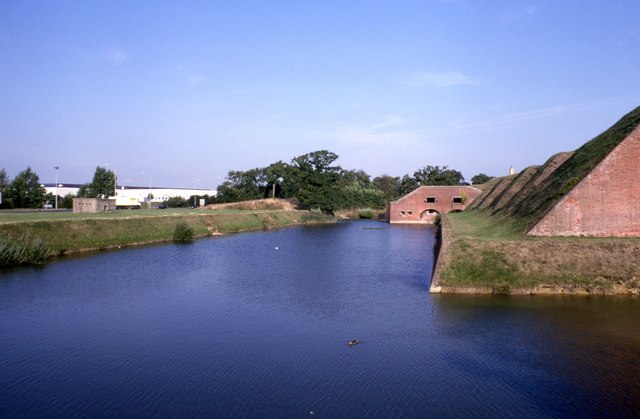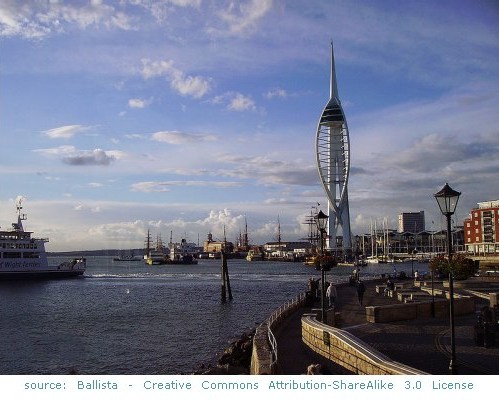


Solent Sites Hampshire Business Directory
Hampshire Places - Winchester

The Romans founded Winchester as Venta Belgarum, and it became their fifth largest city in Britain.
It was the ancient capital of the Kingdom of Wessex: from 590 and in 827 King Alfred the Great kept Winchester as the capital
of the newly unified England, which it remained until after the Norman conquest,
two and a half centuries later.
William the Conqueror was crowned both in London and in Winchester and it was the monks of Winchester
that William I commissioned in 1086 to write his Domesday Book, a survey listing the owners of all
lands and properties in England.
It was ravaged by fire in 1141 and it then fell behind London in importance.
Winchester is of huge historical significance
and its cathedral is one of the finest examples of Gothic architecture in the country.
Within its walls lies the grave of Jane Austen, who died nearby in 1817 and it was here that,
in the Middle Ages, royal court functions were held. It holds the
tombs of bishops and Saxon kings.

Webgloss is a team of Hampshire web designers and programmers based in Gosport, near Fareham, Portsmouth and Southampton, who have been designing websites for businesses since 2001. With a wealth of expertise we can get your business online quickly and we do not charge you an initial design fee! A professional business website with an extremely competitive package.
- NO SET UP FEE.
- £22 a month.
- 5 web pages for your content.
- Designed for Google.
- Mobile friendly, responsive web design.
- No design fees.
- No hidden charges.
- No tie-in contract.
- 2 slideshows if required - each 6 images.
- 2 pages as galleries, if required, max. 30 images on each.
- Static images throughout.
- Up to 10 videos from your You Tube page.
- One visitor contact form.
- Search engine submissions included.
- Most future changes included.
- Your logo incorporated.
- Website header designed if required.
Winchester Cathedral
is built on the site of an older Saxon church,
which itself was an important early Christian centre in Britain. Cynegils, a west Saxon king, was
baptised here in 635, and King Alfred was buried on the site in 899.
In the old chapel of Winchester Castle, now the County Hall, is Arthur's Round Table.
It hangs on the wall at the Eastern end of the Hall and is
described as consisting of stout oaken planks, measuring eighteen feet in diameter: in several places
it is perforated by bullets, Cromwell's men probably finding it useful as a target.
Wintoncester in the tragic Wessex Tale by Thomas Hardy 'Tess of the Durbervilles' was actually a
fictionalised Winchester.
Unfortunately Winchester is full of over-priced housing and the city has an associated snobbery that
is nauseating but part of me is still intrinsically linked to the place. I was born there and
spent many years at three of Winchester's schools; St Swithuns,
Weeke Primary and the County High Grammar School (which was an all girls school then).
I hated all three but that is no reflection on them - I hated authority and the sense
of being in an institution. I returned to Winchester when I was 16 and had a brilliant seven
years as a teenager and young adult.. the culture of Winchester, combined with easy access to the
night life of Southampton, Oxford and London provided an ideal existence in some ways until I
left when I married at the age of twenty three.
Having spent years loving the novels of Jane Austen and the mythical tales
of Merlin and Arthur, it is strange that I have only recently begun to regret not taking more
notice of the historic significance of my surroundings when I was a teenager in Winchester. I was too busy doing other things
to appreciate the history that surrounded me - a history that many people will travel thousands of miles to briefly glimpse.
A while ago I read a 'blog' of a Jane Austen fanatic who flew to England to visit Winchester.
I didn't read it all because she kept praising the lord and the depth of her fascination with Jane Austen touched
on the weird - but even so, it struck me that I had missed so much whilst living there and that I should
re-visit to enjoy some of the history that Americans pay so much to experience.
John Keats may have been born in London and his grave may be in Rome but it was in Hampshire, in
Winchester, during a long stay in 1819, that he wrote the beautiful and macabre Isabella. Isabella and
Lorenzo are in love but Isabella's brothers kill Lorenzo. After finding his body, she put his head inside of a
pot of basil (the basil herb symbolises love). Keats died two years later, on 23rd February 1821, aged 25.
He specifically asked that his name not appear on his gravestone and that instead it should bear the inscription
'Here lies One Whose Name was writ in Water'.
Hampshire Places - The New Forest
During the middle ages Hampshire had more Royal Forests than any other county and
the New Forest remains largely intact.
It was created as a royal forest around 1080 by William the Conqueror for
hunting and was first recorded as "Nova Foresta" in the Domesday Book in 1086.
The area contains several kinds of important lowland habitat
including valley bogs, wet heaths, dry heaths and deciduous woodland.Three species of snake inhabit the Forest. The adder is the most common being found on open heath and grassland. The grass snake prefers the damper environment of the valley mires.
The rare smooth snake can be found on sandy hillsides with heather and gorse.


Two of William's sons died in the forest, Prince Richard in 1081 and William Rufus in 1100.
William Rufus, William 2nd, Kind of England from 1087 until 1100, who allegedly hated the English and their culture,
was shot with an arrow and some suspect that William's brother Henry was the one who shot the arrow that killed him,
as he was among the hunting party that day and shortly after was crowned king.
The reputed spot of the Rufus' death is marked with a stone known as the Rufus Stone.
One of the prettiest areas close by is Bucklers Hard, part of the Beaulieu Estate,
with Georgian cottages running down to the river.
Hampshire Places - Alton and Alresford
Old Alresford is a village in Hampshire situated just north of the town New Alresford
which is south-west of the town of Alton.
Jane Austen lived at the nearby village of Chawton.
The Treaty of Alton was an agreement in which William the Conqueror's eldest son Robert agreed
to recognize Henry as king of England (Henry I).
It was signed in 1101 after Henry had seized the throne while his older brother
was away on the first crusade.
Robert had returned to claim the throne and they met in Alton
to agree terms which formed the Treaty of Alton.
Part of the main street through Alton is called Normandy Street, probably reflecting this event.
The Watercress Line Steam Railway
The Watercress Line is the Mid-Hants Railway, a heritage line in Hampshire.
It runs steam and diesel trains and stretches 10 miles from New
Alresford to Alton where it connects to the national rail network.
Its name comes from the days when
it was used to transport locally grown watercress to markets in London.
Alresford is often considered the watercress capital of Britain.
Watercress is well-suited to hydroponic cultivation, thriving best in water that is slightly
alkaline. It is frequently produced around the headwaters of chalk streams.
In many local markets the
demand for hydroponically-grown watercress exceed supplies.

Watercress Line - by Kabads at the English language Wikipedia, CC BY-SA 3.0, https://commons.wikimedia.org/w/index.php?curid=4415581
Fanny Adams
On Saturday August 24th 1867 8 yr old Fanny Adams was murdered by solicitor's clerk
Frederick Baker in Alton, Hampshire.
The expression 'sweet Fanny Adams', a slang phrase meaning
'nothing at all', refers to this Fanny.
Fanny went along Tanhouse Lane towards Flood Meadow with her sister Lizzie and friend Millie Warner
where they met Frederick Baker who offered them money.
He carried Fanny into a hop field, out of sight of the other girls.
When later questioned Baker said he had given the girls money for sweets, but that was all.
Fanny's body was found in the hop field, horribly butchered.
The doctor's surgery where her severed body was put back together is now a pub
called Ye Olde Leathern Bottle and it is believed to be haunted by Fanny Adams.
The police actually found an entry in Baker's diary '24th August, Saturday —
killed a young girl. It was fine and hot.'
The jury returned a verdict of
wilful murder and Baker was committed for trial at the
Winchester County Assizes.
At his trial on 5 December, the defence argued insanity: Baker's father had been
violent, a cousin had been
in asylums, his sister had died of a brain fever and he himself
had attempted suicide after a love affair.
Justice Mellor invited the jury to consider a verdict of not responsible
by reason of insanity, but they returned a guilty verdict after just
fifteen minutes. On Christmas Eve Baker was hanged outside
Winchester Gaol.
This execution was the last to take place at Winchester.
Hampshire Places - Gosport
The name Gosport used to be 'Goseport' and is believed to be derived from the
word 'goose'. It is across the water from the city of Portsmouth and the two are
linked by the Gosport Ferry. Both Rowner and Alverstoke in Gosport
were mentioned in the Domesday Book. Gosport's railway station is now a ruin overgrown with weeds but it used to be a
bustling centre of activity and was
favoured by Queen Victoria who used it on her way to Osbourne House on
the Isle of Wight.
Prince Albert greeted Louis Philippe of France at Gosport
and Albert negotiated the construction of an extension of the line through
the town ramparts to a private station, the Royal Victoria Station, built in
Royal Clarence Yard for the use of Royal family and household.
William Wilberforce's son, Samuel Wilberforce was made Rector of Alverstoke in Gosport in 1840. Known as 'Soapy Sam', Samuel Wilberforce was
a great public speaker and is known for his opposition to
Charles Darwin's theory of evolution.

credit: Barry Shimmon / Moat around Fort Brockhurst (1) / CC BY-SA 2.0
They would arrive here for the Solent crossing and for the next fifty years, Victoria and her party landed here for her
summer holiday at Osborne. The private station was last used for passengers following Victoria's death in 1901,
when her coffin, accompanied by her mourning family, was taken across the Solent for the last time.
Following Victoria's death, her successor, Edward VII, found Osborne an inconvenient white elephant, and gave the house to the nation.
During World War I Gosport's station was in demand with supplies going to and from Royal Clarence Yard and
also large numbers of troop movements including the transportation of the wounded en route to Haslar Hospital.
It was used in World War II by the military including transporting supplies, hospital trains
and trains carrying prisoners of war on their way to a local internment camp. On the night of 10 March 1941 the station received a direct hit
from an aerial attack, the main damage being to the roofing which caught alight and collapsed.
Gosport's railway station closed to passengers in 1953 but freight traffic remained until 30 January 1969, when the station closed to all traffic.
Stokes Bay
The pebble beach at Stokes Bay slopes steeply into the sea and offers fine views of the shipping going in and out of Portsmouth and Southampton and the many pleasure craft from the many marinas along The Solent and the Isle of Wight. Stokes Bay and the Solent are popular areas for yachting.
The Royal Navy Submarine Museum
This unique Museum offers you the chance to walk on board a real submarine, discover true tales of heroism and relive a life under the sea through the personal belongings of the crew. Imagine what it must be like to be depth charged? Picture yourself in a tiny miniature submarine about to slip under an enemy ship; you can experience the reality at the Royal Navy Submarine Museum. Trace the history of submarine development, from Alexander the Great, to Holland I, to the giant nuclear powered Vanguard class of the present day peace keepers. The Museum also serves as the Regimental Headquarters for past submariners. It houses a huge collection of photographs, transcripts, artifacts and archive material.
Fort Brockhurst
Fort Brockhurst is one of the 'Palmerston's Follies', built in the 1850s to defend Portsmouth Harbour against threats of a French invasion. A central exhibition explains Palmerston's plans to defend the key naval port. Nearby is the Gosport Aviation Heritage Museum, dedicated to the development of the Royal Air Force. The fort is owned by English Heritage.
Living History Village
Gosport is also home to The 1642 Living History Village.
The village exists to educate both
children and adults about 17th Century life at the outbreak of the English Civil War and is open for
the public to meet the villagers at certain times throughout the year.
Living History Village of Little Woodham is dedicated to recreating English rural life in the South of England during 1642.
Within the Parish of Rowner, surrounded by woodland, the village of Little Woodham exists to educate both children and adults about 17th
Century life at the outbreak of the English Civil War.
In the April of 1642 the King of England, Charles Stuart and his Parliament stood on the eve of Civil War. The momentous events of that
year unfold as the fall approaches. Using extensively researched local events and people the villagers link their families and their
lives to national and international events.
During your walking tour you will meet 'villagers', interpreters dressed in historic period costume. Little Woodham's living
history interpreters involve you and your children in their daily lives. Prepare timber with the sawyers at their camp, or
speak with villagers as they make lace, or card and spin wool. Those visitors with "good and lawful money of England" may enter
Little Woodham's ale-house, there to join in conversation with whomever they may find within.
For more information about Gosport visit Gosport Info, a
site produced by Ian Jeffery.
Hampshire Places - Southampton
It is likely that there have been settlements on the present site of Southampton since the
stone age. It is now the largest city in Hampshire and
became the major port for travel between
the then capital of England, Winchester, and Normandy after 1066.
Southampton Castle was built in the 12th
century.
By the 13th century Southampton had become a leading port, particularly involved in
the trade of French Wine in exchange for English cloth and wool.
Southampton city walls include God's House Tower, built in 1417,
the first purpose-built artillery fortification in England.
Over the years it has been used as home to the city's gunner and as, the
Town Jail.
Today, it is open as the Museum of Archaeology.
The walls were completed in the 15th century, but later development of several
new fortifications along Southampton Water and the Solent by Henry VIII,
meant that Southampton was no longer dependent upon its fortifications.

Image by Christophe.Finot - Own work, CC BY-SA 2.5, https://commons.wikimedia.org/w/index.php?curid=1023633
The Black Death
In 1348, the Black Death reached England via merchant vessels calling at Southampton. This Black Plague was one of the deadliest pandemics in human history and it existed in England for hundreds of years. The Great Plague of London (1665–1666) which killed over 75,000 people in is generally recognized as one of the last major outbreaks. The plague was blamed upon the French at the time (although later this was strongly disputed) as, in April 1665, two infected French sailors were said to have collapsed and died at the junction of Drury Lane and Long Acre in London. The British outbreak is actually thought to have originated from the Netherlands, where the bubonic plague had existed since 1599.
The Pilgrims' Voyage
Southampton port was the original point of departure for the Pilgrim Fathers aboard
the Mayflower in 1620 - the famous voyage to Plymouth, Massachusetts.
Initially, the plan was for the voyage to be made in two vessels, the other being the smaller
Speedwell. The first voyage of the ships departed Southampton on August 5, 1620,
but the Speedwell developed a leak, and had to be refitted at Dartmouth.
On the second attempt, the ships reached the Atlantic Ocean but again were forced to return to
Plymouth because of the Speedwell's leak.
It would later be revealed that there was in fact nothing wrong with the Speedwell. The crew had
sabotaged it in order to escape the year-long commitment of their contract.
The final sixty-six day voyage was made by the Mayflower alone, leaving from
near to the Mayflower Steps in Plymouth, England on September 6th.
A small party of religious separatists who comprised about half of the
passengers on the ship wanted a life where they could practice their religion freely.
This symbol of religious freedom resonates in US society today and the story of the Mayflower
is a staple of any American history textbook. Americans whose roots are traceable
back to New England often believe themselves to be descended from Mayflower passengers.
Today a replica of the original Mayflower, The Mayflower II is,
built in the 1950s can be visited in Plymouth harbour where many tourists every year, climb aboard and get to tour the magnificent ship.
The Titanic
The Titanic was a four funnelled ocean liner built for the transatlantic passenger and mail service between Southampton and New York.
On Wednesday, 10 April 1912 she sailed from Southampton on her maiden voyage bound for New York City, New York.
As the Titanic left her berth, her wake caused the liner New York, which was docked nearby, to break away from her moorings and was
drawn dangerously close (about four feet) to the Titanic before a tugboat towed the New York away. The near accident delayed departure for one hour.

The Titanic stopped at Cherbourg, France, to board additional passengers and stopped again the next day at
Queenstown (Cobh), Ireland, before continuing towards New York with 2,240 people
aboard.
At 11:40 pm a large iceberg directly ahead of the ship was seen.
An
abrupt turn to port (left) and full speed astern began the process of stopping and reversing
the ship's engines but a collision was inevitable and the iceberg brushed the ship's starboard
(right) side, buckling the hull in several places and popping out rivets below the waterline over
a length of 300 feet.
The ship had been designed to be able to stay afloat with four flooded compartments but
five filled with water and weighed down the ship so that the tops of the forward watertight
bulkheads fell below the ship's waterline, allowing water to pour into additional compartments.
The closest ship was Cunard Line's RMS Carpathia 58 miles away, which arrived too late to rescue
all of Titanic's passengers. As the forward funnel collapsed it crushed people in the water.
Nearly every first-class woman survived, compared to 86% of those in second class and less than half of those in third class.
The people of Southampton were deeply affected by the sinking of the Titanic. According to the Hampshire Chronicle on April 20, 1912,
almost 1,000 local families were directly affected. Almost every street in the Chapel district of the town lost more than
one resident and over 500 households lost a member.
Southampton was later the home port for the transatlantic passenger services operated by
Cunard and their Blue Riband liner RMS Queen Mary and her sister ship RMS Queen Elizabeth.
Hampshire Places - Portsmouth
Everyone knows that Charles Dickens was born in Landport, Portsmouth in 1812 but few know that
the very first Sherlock Holmes novel, 'A Study in Scarlet', was written in Southsea in Portsmouth
by Sir Arthur Conan-Doyle or that Peter Sellers was born in Southsea in 1925 and his birthplace is on
the corner of Castle Road
and Southsea terrace with blue plaques that say 'Peter Sellers, Actor and Comedian was born here'.
Isambard Kingdom Brunel who helped plan the Thames Tunnel and the Clifton Suspension
Bridge as well as
design the first steamship built to cross the Atlantic, the Great Western, was also born in Portsmouth, in 1806.

Southsea beach and Portsmouth Harbour were military embarkation points for the D-Day landings on June 6 1944 and Southwick House, just to the north of Portsmouth, was the headquarters for the Supreme Allied Commander, US General Dwight D. Eisenhower, during D-Day.
After the war they tried to improve the quality of housing in the city without very much success. Redevelopment was characterised by utilitarian and brutalist architecture, with Portsmouth's Tricorn Centre one of the most famous examples. More recently, a new wave of redevelopment has seen Tricorn's demolition, the renewal of derelict industrial sites, and the construction of the Spinnaker Tower. This tower is the centrepiece of the redevelopment of Portsmouth Harbour, which was supported by a National Lottery grant. Its shape was chosen by Portsmouth residents from a selection of concepts. Designed by local firm HGP Architects and the engineering consultants Scott Wilson and built by Mowlem, it reflects Portsmouth's maritime history and represents a sail. After several years of delays it was finally opened to the public on 18 October 2005.
At a height of 558 feet above sea level, it is 2.5 times higher than Nelson's Column, making it the tallest accessible structure in the United Kingdom outside London. Visible for miles around Portsmouth it has completely altered the area's horizon.
Lord Nelson's flagship at the Battle of Trafalgar, HMS Victory, built between 1759 and 1765, sits in dry dock in Portsmouth as a museum ship alongside HMS Warrior which was was the largest and fastest warship of her day.
Old Portsmouth
Different from the rest of Portsmouth in almost every imaginable way is
Old Portsmouth in the south west corner of Portsea Island.
It is the original town of Portsmouth and houses Portsmouth Cathedral,
The Royal Garrison Church,
The Square Tower and Round Tower and Point Barracks, and also the entrance to the harbour.
The Round Tower was built between 1418 and 1426, overlooking the entrance to the harbour and the
adjoining Square Tower was built in 1494.
Long Curtain and Kings Bastion defences were added in the 17th century.
Hampshire Places - The Isle of Wight
The Isle of Wight Festival
The Isle of Wight Festival is a music festival which takes place annually on the Isle of Wight.
The 1970 event, the third Isle of Wight Festival, was by far the largest with a crowd of over
600,000 people
and was said at the time to be one of the largest human
gatherings in the world, surpassing the attendance at Woodstock.
Dr Robin Farquharson is said to have told everyone to pull down the fences and make it a free
festival - he is a man who ditched a successful university career and simply dropped out, living on
the streets of London.
Included in the line-up of over
fifty performers were The Who, Jimi Hendrix, Miles Davis, The Doors, Ten Years After,
Emerson Lake and Palmer, Joni Mitchell, The Moody Blues, Melanie, Donovan, Free,
Chicago, Richie Havens, John Sebastian, Leonard Cohen, Jethro Tull, Taste and Tiny Tim.
The unexpectedly high attendance levels meant inadequate
amenities and crowds that became out of control at times which led in 1971 to
the 'Isle of Wight Act' being passed to prevent gatherings of more than 5,000 people on
the island without a special licence.
The 1970 festival was also
filmed by a professional film crew but the footage wasn't released until
2003.
Jimi Hendrix sang God Save the Queen, Sgt.Pepper's Lonely Hearts Club Band, Spanish Castle Magic,
All Along the Watchtower, Machine Gun, Lover Man, Freedom, Red House, Dolly Dagger, Foxey Lady,
Message to Love, Ezy Ryder, Purple Haze, Voodoo Child (Slight Return) and In from the Storm.
He died less than 3 weeks later.

By Warner/Reprise Records Uploaded by We hope at en.wikipedia - eBay item photo front photo back. Transferred from en.wikipedia by SreeBot, Public Domain, https://commons.wikimedia.org/w/index.php?curid=17011402
In 686, The Isle of Wight became the last part of England to convert to Christianity.
It lies just south of Hampshire separated from the mainland by the sweep of the Solent
which is so popular for sailing due to its sheltered water.
It used to be part of Hampshire but became an independent administrative county in 1890.
It is believed that The Needles were once connected to the Old Harry Rocks near Swanage.
They are a row of three distinctive stacks of chalk that rise out of the sea off the
western extremity of the Isle of Wight close to Alum Bay with a lighthouse, designed
by James Walker, at the western end.
They take their name from the former fourth needle-shaped pillar called Lot's Wife
that used to stand in its midst until it is said to have collapsed in a storm in 1764.
However, a drawing of The Needles by Dutch landscape artist Lambert Doomer
in 1646 depicts a rock formation with much stouter shape than that shown in
Isaac Taylor's 1759 'one inch' map of Hampshire and so we are unsure of whether there ever was
a rock that was actually needle shaped!
In the Spring and Summer there are open-top bus trips
along the cliff edge and the whole area is a popular destination for tourists.
Just off the end of the Needles formation is the Shingles, a shifting shoal of pebbles
just beneath the waves around three miles long. Here many ships have
been wrecked and it is an area that is best avoided when sailing in the Solent.
Alfred, Lord Tennyson
Alfred Tennyson (1809 – 1892) was Poet Laureate (after William Wordsworth's death in 1850)
and Queen Victoria was an ardent admirer of his work making him Baron Tennyson, of Aldworth in the
County of Sussex and of Freshwater in the Isle of Wight in 1884.
His poetry often imitated the style of other poets such as Byron, whom he greatly admired and one
of his greatest poems is Idylls of the King (1885), a series of narrative poems
based on King Arthur and Arthurian tales.
Tennyson spent a considerable time staying in Freshwater on the Isle of Wight
and he asked that his poem 'Crossing the Bar' (1889)
be placed as the last in all of his published anthologies.
He wrote the poem after a serious illness while at sea, crossing the Solent from Aldworth to
Farringford on the Isle of Wight. Tennyson explained part of the poem thus:
"The Pilot has been on board all the while, but in the dark I have not seen him… that Divine
and Unseen Who is always guiding us."
SUNSET and evening star,
And one clear call for me!
And may there be no moaning of the bar,
When I put out to sea,
But such a tide as moving seems asleep,
Too full for sound and foam,
When that which drew from out the boundless deep
Turns again home.
Twilight and evening bell,
And after that the dark!
And may there be no sadness or farewell,
When I embark;
For tho' from out our bourne of Time and Place
The flood may bear me far,
I hope to see my Pilot face to face
When I have crost the bar.
Towards the end of his life Tennyson revealed that his "religious beliefs also defied convention,
leaning towards agnosticism and pandeism". Famously, he wrote in In Memoriam: "There lives
more faith in honest doubt, believe me, than in half the creeds."
Queen Victoria
Queen Victoria
made Osborne House in East Cowes on the Isle of Wight her summer home for many years and, as a
result, it became a major holiday resort for fashionable Victorians including Alfred Lord Tennyson,
Julia Margaret Cameron, Charles Dickens and members of European
royalty.
She her husband Prince Albert bought Osborne House on the Isle of Wight in 1845
as a home away from the stresses of court life.
Its views of the Solent reminded
Albert of the Bay of Naples in Italy but they pulled down the original house and built a new
Osborne House in the style of the Italian Renaissance and designed by Prince Albert.
In the grounds is the 'Swiss Cottage' which was brought piece by piece from
Switzerland as a gift to Queen Victoria's children on her
birthday in 1854.
In December 1861, Prince Albert died at Windsor Castle and Osborne House
continued as one of Queen Victoria's favourite homes. As a widow, Victoria went into impenetrable
mourning. She retreated to Windsor and Osborne with her memories.
The private royal apartments were effectively sealed off in a time capsule with
everything preserved as if Albert were still alive.
The domestic routine also continued as though Albert were still alive, even to the extent of his
shaving things and clothes being laid out for him each day.
She died at Osborne on 22 January 1901
During World War II Adolf Hitler, believing that Osborne House could become
one of his post-war retreats, gave orders that the Osborne Estate should not be bombed.
Cowes
Leland's nineteenth century verses described the towns of Cowes as "The two great Cowes that in loud thunder roar, this on the eastern, that the western shore". The two towns are linked by the Cowes Floating Bridge, a chain ferry and Cowes is renowned for sailing with some of the world's most elite yacht clubs. The town gives its name to the world's oldest regular regatta, Cowes Week, which occurs annually in the first week of August. Later on in the summer, powerboat races are held.


All Design & Images Copyright © All Rights Reserved - Web Designers Hampshire - Biz 1st for Business Start Ups - Mini Pixels Directory - .